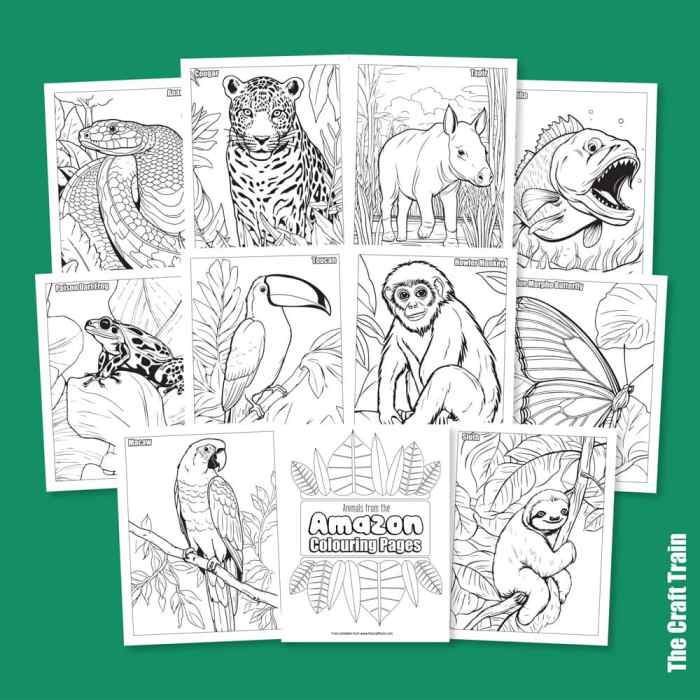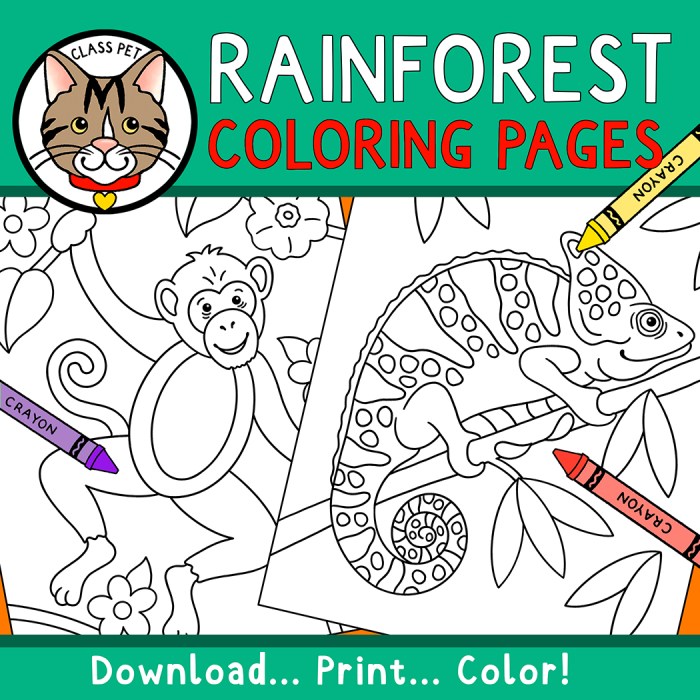Artistic Aspects of Rainforest Animal Coloring Sheets

Rainforest animals coloring sheet – Rainforest animal coloring sheets, seemingly simple, are miniature canvases brimming with artistic potential. Their creation involves a delicate balance between scientific accuracy, child-friendly design, and the captivating allure of the rainforest itself. The artistic choices made significantly impact a child’s engagement and the overall learning experience.
Artistic Styles Employed in Rainforest Animal Coloring Sheets
The styles used in rainforest animal coloring sheets range widely, catering to diverse age groups and aesthetic preferences. Some sheets embrace a realistic approach, meticulously detailing the animal’s fur, scales, or feathers, mirroring nature’s intricate designs. Think of a jaguar, its spotted coat rendered with painstaking accuracy, each spot individually shaped and sized. Others adopt a more cartoonish style, employing simplified shapes and exaggerated features for a playful, whimsical feel.
Imagine a toucan with oversized, vibrant beak, its body reduced to charming, child-friendly proportions. A third approach leans towards a more stylized aesthetic, perhaps using geometric patterns or bold lines to represent the animal’s form, creating a unique, artistic interpretation of the subject. This could be a monkey, its silhouette rendered in bold, graphic shapes, evoking a sense of movement and energy.
Color Palettes and Techniques
The color palette significantly contributes to the overall mood and effectiveness of a coloring sheet. Realistic depictions often utilize a muted palette mirroring the natural colors of the rainforest, with earthy browns, greens, and yellows dominating the scene. However, vibrant hues are also frequently incorporated, reflecting the brilliance of certain rainforest creatures like parrots or poison dart frogs.
Coloring sheets may employ various techniques such as gradients to suggest depth and dimension, or hatching and cross-hatching to build texture and form. For instance, a macaw’s feathers might be rendered with subtle gradients, transitioning from a deep blue to a bright turquoise, while a sloth’s fur could be depicted with fine hatching lines to suggest its thick, coarse texture.
Creating a Rainforest Animal Coloring Sheet: A Step-by-Step Process
The process typically begins with research, gathering accurate visual references of the chosen rainforest animal. This is followed by sketching, initially outlining the animal’s basic form and gradually adding details. Once the sketch is refined, it’s transferred to a clean sheet of paper, possibly digitally. Next comes the line art phase, where the sketch is meticulously refined into clean, distinct lines ready for coloring.
Line weight is crucial here; thicker lines for Artikels and finer lines for details. Finally, the coloring sheet is ready for printing or digital distribution. Consider the example of a sloth; initial sketches focus on its posture and body shape, followed by detailed rendering of its fur and claws. The final line art emphasizes the curves of its body and the texture of its fur.
Artistic Elements Enhancing Visual Appeal
Several artistic elements contribute to a coloring sheet’s visual appeal. Appropriate line weight creates clear Artikels and visual hierarchy. Careful composition, including thoughtful placement of the animal within the frame, guides the viewer’s eye. A balance between detail and simplicity is essential; too much detail can overwhelm, while too little makes the sheet uninteresting. Consider the use of negative space strategically to allow for breathing room and prevent the design from feeling cramped.
For example, a well-composed coloring sheet featuring a monkey might place the animal slightly off-center, leaving ample space around it to enhance its prominence. The level of detail should be appropriate for the target age group, with younger children benefiting from simpler designs and older children appreciating more intricate details.
Rainforest animals coloring sheets offer a vibrant introduction to the jungle’s incredible biodiversity. Understanding these creatures is enhanced by learning about their basic building blocks; a deeper look into cells is possible with helpful resources like plant and animal cell coloring worksheets , which illustrate the microscopic world supporting all life, including those fascinating rainforest animals. Returning to our colorful sheets, remember to shade the toucans’ beaks brilliantly!
Target Audience and Marketing of Rainforest Animal Coloring Sheets

The vibrant hues of the rainforest, translated onto paper through the whimsical forms of its creatures, hold a unique appeal. Understanding who will be captivated by these coloring sheets and how best to reach them is key to their success. This involves careful consideration of the target audience, the marketing channels, and a cohesive marketing plan that weaves together these elements.The primary target audience for rainforest animal coloring sheets is multifaceted, encompassing children, educators, and even adults seeking a creative outlet or a connection to nature.
Children, particularly those aged 3 to 12, form a significant segment due to their inherent fascination with animals and the engaging nature of coloring activities. Educators can utilize these sheets as valuable learning tools in classrooms, integrating them into lessons about biodiversity, conservation, and the rainforest ecosystem. Adults, too, find solace and creative expression in coloring, and the rainforest theme offers a captivating escape into a world of lush greenery and exotic animals.
Identifying the Primary Target Audience
The target audience isn’t a monolithic entity; it’s a diverse group with varied needs and preferences. Children’s interests range from simple designs to more intricate details, influencing the complexity of the animal illustrations. Educators require sheets that align with curriculum goals, perhaps including educational information about each animal. Adults, on the other hand, might appreciate more detailed illustrations allowing for nuanced coloring techniques and a meditative coloring experience.
A successful marketing strategy must cater to these diverse needs, offering a range of designs and perhaps even accompanying educational materials.
Marketing Strategies for Rainforest Animal Coloring Sheets
Several effective marketing strategies can be employed to reach the diverse target audience. Online marketing offers a broad reach, leveraging websites, e-commerce platforms like Etsy or Amazon Handmade, and social media platforms such as Instagram and Pinterest. Visual platforms like Pinterest, in particular, are well-suited to showcasing the vibrant designs of the coloring sheets. Print marketing, though potentially less cost-effective for a wide reach, can be targeted to specific groups like schools or educational organizations through brochures or flyers.
Collaborations with educational institutions, environmental organizations, or even zoos and aquariums could provide access to specific target audiences and build credibility.
Comparing Marketing Channel Effectiveness
Online marketing, particularly through social media, offers significant advantages in terms of reach and cost-effectiveness. Targeted advertising on platforms like Facebook and Instagram allows for precise targeting based on demographics and interests, ensuring the coloring sheets reach the most receptive audience. The visual nature of these platforms makes them ideal for showcasing the colorful designs. Print marketing, while less scalable, can offer a more tangible and personal touch, especially when targeting specific organizations or events.
The effectiveness of each channel will depend on the budget and the specific marketing goals. For example, a smaller budget might focus primarily on social media marketing, while a larger budget might incorporate a mix of online and print strategies.
Marketing Plan for Rainforest Animal Coloring Sheets
A comprehensive marketing plan should integrate both online and offline strategies. This plan could begin with the creation of a visually appealing website showcasing the coloring sheets and offering online purchasing options. Simultaneously, a social media campaign would utilize high-quality images and videos to generate interest and engagement. Targeted advertising on relevant platforms will ensure that the right audience sees the product.
Collaborations with educational institutions and environmental organizations could lead to bulk orders and increased brand visibility. Participating in relevant craft fairs or educational events could provide a direct channel to reach potential customers and offer a more personal experience. Finally, utilizing email marketing to engage with potential and existing customers would help in promoting new designs and special offers.
This multi-faceted approach aims to maximize reach and engagement across the diverse target audience.
Illustrative Examples of Rainforest Animals: Rainforest Animals Coloring Sheet

The vibrant tapestry of the rainforest teems with life, a symphony of colors and sounds. To capture this essence in a coloring sheet, we need to distill the complexity of these creatures into simplified, yet recognizable forms. This requires understanding their unique characteristics and how they interact with their environment. The following examples illustrate how to achieve this for three iconic rainforest inhabitants.
Monkey Physical Characteristics and Habitat
Monkeys, with their diverse species, exhibit a wide range of physical characteristics. Let’s consider a common example, the Capuchin monkey. Their fur is typically a blend of browns and blacks, providing excellent camouflage within the dappled light of the rainforest canopy. They are relatively small primates, ranging from 1 to 2 feet in length, with long, agile limbs perfect for swinging through trees.
Their prehensile tails act as a fifth limb, offering stability and balance. Capuchins are highly social animals, living in troops that can number up to 40 individuals. Their habitat consists of the upper layers of the rainforest, where they feed on fruits, insects, and nuts. They interact with various other animals, sometimes competing for food resources or forming symbiotic relationships with other tree-dwelling creatures.
Toucan Physical Characteristics and Habitat
The toucan, instantly recognizable by its enormous, brightly colored beak, is another rainforest icon. Their feathers are predominantly black, providing a striking contrast to their vibrant beak, which can range from orange and yellow to red and green, depending on the species. These beaks, while impressive, are surprisingly lightweight, constructed from a spongy bone structure. Toucans are medium-sized birds, roughly the size of a crow.
Their strong feet are adapted for gripping branches, while their beaks are used for reaching fruit and other food items. Toucans inhabit the rainforest canopy, nesting in tree hollows. They often interact with other birds and compete for resources such as fruit and insects. Their diet also includes small reptiles and amphibians.
Sloth Physical Characteristics and Habitat, Rainforest animals coloring sheet
Sloths, masters of camouflage and slow movement, are remarkably adapted to their arboreal lifestyle. Their fur is coarse and often hosts algae, giving it a greenish tinge that helps them blend seamlessly into the rainforest foliage. They are relatively large, with a body length of around 2 feet. Their long limbs and curved claws are perfectly designed for hanging from branches.
Sloths are solitary creatures, spending most of their lives hanging upside down in the rainforest canopy. They primarily feed on leaves, buds, and tender shoots. Their slow metabolism and deliberate movements make them remarkably energy-efficient. Their interactions with other animals are limited, primarily due to their sedentary nature, though they may share their habitat with various insects and other arboreal creatures.
Simplified Depiction for Coloring Sheets
To create suitable coloring sheets, it is important to simplify the animal’s features while retaining their essence. Overly detailed illustrations can be difficult for young children to color.
Key Features to Illustrate for Each Animal
- Monkey: Round head, expressive eyes, long limbs, prehensile tail, simplified fur markings.
- Toucan: Large, colorful beak, black body, short legs, strong feet.
- Sloth: Rounded body, long limbs, curved claws, simplified fur with a suggestion of green coloration.
